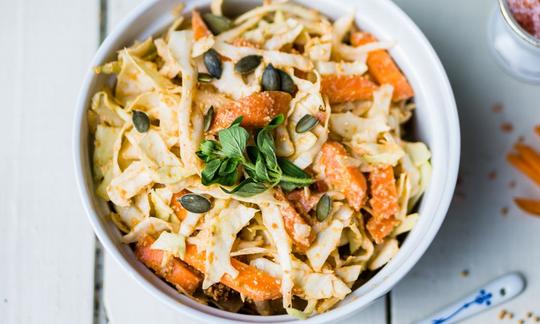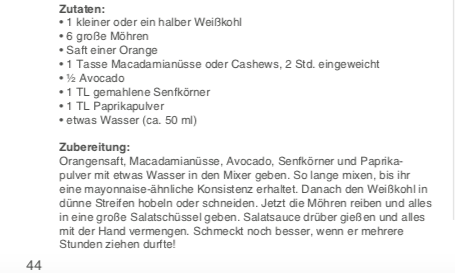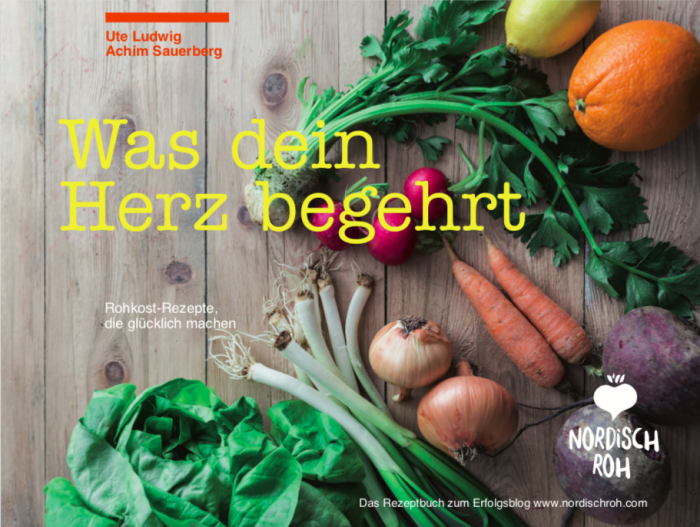Raw Vegan Irish Coleslaw with Macadamia Nuts and Orange
raw-vegan
Ingredients (for servings, )
| For the dressing | |
|---|---|
| 1 cup | Macadamia nuts, raw (organic?) (4.7 oz) |
| 1 | Oranges, raw (organic?) (4.6 oz) |
| ½ | Avocados, raw (organic?) (3.5 oz) |
| 1 tsp, ground | Mustard seeds, yellow-white (raw, organic?) (0.16 oz) |
| 1 tsp | Paprika powder, hot (raw?, organic?) (0.08 oz) |
| 50 ml | Drinking water, raw (organic?) (1.8 oz) |
| For the salad | |
| ½ | White cabbage (white cabbage, raw cabbage, organic?) (29 oz) |
| 6 | Carrots (carrots), raw (organic?) (13 oz) |
Equipment
- food processor or blender
- grater
- citrus juicer (lemon squeezer)
Type of preparation
- chop or grind
- food preparation without heating
- blend
- squeeze
- grate (shred)
Preparation
Preparation
Soak macadamia nuts for about two hours. Squeeze orange(s).The authors have suggested cashews as an alternative to macadamia nuts (also soaking time 2 hours). However, these are rarely raw and have a much worse fatty acid ratio.
For the dressing
Put orange juice, soaked macadamia nuts, avocado, mustard seeds and paprika powder into the blender with a little water. Blend until you get a mayonnaise-like consistency.For the salad
Slice or cut the white cabbage into thin strips. Now grate the carrots and put everything in a large salad bowl.finishing and serving
Pour the salad dressing over the white cabbage and carrot mixture and mix everything together by hand.Tip from the authors: The salad tastes even better if it is left to sit for several hours!
|
Nutritional Information per person
Convert per 100g
|
2000 kcal | |
|---|---|---|
| Energy | 522 kcal | 26.1% |
| Fat/Lipids | 40 g | 57.0% |
| Saturated Fats | 6.3 g | 31.4% |
| Carbohydrates (inc.dietary fiber) | 43 g | 15.8% |
| Sugars | 21 g | 23.5% |
| Fiber | 18 g | 70.9% |
| Protein/Albumin | 9.7 g | 19.4% |
| Cooking Salt (Na:139.0 mg) | 353 mg | 14.7% |
| Essential micronutrients with the highest proportions | per person | 2000 kcal | |
|---|---|---|---|
| Vit | Vitamin K | 230 µg | 307.0% |
| Vit | Vitamin C (ascorbic acid) | 134 mg | 167.0% |
| Vit | Vitamin A, as RAE | 1'058 µg | 132.0% |
| Min | Manganese, Mn | 2.6 mg | 128.0% |
| Vit | Vitamin B9, B11 (Folate, as the active form of folic acid) | 186 µg | 93.0% |
| Vit | Vitamin B1 (Thiamine) | 0.85 mg | 77.0% |
| Elem | Potassium, K | 1'286 mg | 64.0% |
| Prot | Threonine (Thr, T, irreversibly transaminated) | 0.54 g | 58.0% |
| Min | Copper, Cu | 0.54 mg | 54.0% |
| Vit | Vitamin B6 (pyridoxine) | 0.76 mg | 54.0% |
Detailed Nutritional Information per Person for this Recipe
The majority of the nutritional information comes from the USDA (US Department of Agriculture). This means that the information for natural products is often incomplete or only given within broader categories, whereas in most cases products made from these have more complete information displayed.
If we take flaxseed, for example, the important essential amino acid ALA (omega-3) is only included in an overarching category whereas for flaxseed oil ALA is listed specifically. In time, we will be able to change this, but it will require a lot of work. An “i” appears behind ingredients that have been adjusted and an explanation appears when you hover over this symbol.
For Erb Muesli, the original calculations resulted in 48 % of the daily requirement of ALA — but with the correction, we see that the muesli actually covers >100 % of the necessary recommendation for the omega-3 fatty acid ALA. Our goal is to eventually be able to compare the nutritional value of our recipes with those that are used in conventional western lifestyles.
| Essential fatty acids | per person | 2000 kcal |
|---|---|---|
| Linoleic acid; LA; 18:2 omega-6 | 1.4 g | 14.0% |
| Alpha-Linolenic acid; ALA; 18:3 omega-3 | 0.20 g | 10.0% |
| Essential amino acids | per person | 2000 kcal |
|---|---|---|
| Threonine (Thr, T, irreversibly transaminated) | 0.54 g | 58.0% |
| Tryptophan (Trp, W) | 0.10 g | 38.0% |
| Phenylalanine (Phe, F) | 0.52 g | 34.0% |
| Isoleucine (Ile, I) | 0.38 g | 30.0% |
| Valin (Val, V) | 0.44 g | 27.0% |
| Leucine (Leu, L) | 0.60 g | 25.0% |
| Lysine (Lys, K, irreversibly transaminated) | 0.34 g | 18.0% |
| Methionine (Met, M) | 0.10 g | 10.0% |
| Vitamins | per person | 2000 kcal |
|---|---|---|
| Vitamin K | 230 µg | 307.0% |
| Vitamin C (ascorbic acid) | 134 mg | 167.0% |
| Vitamin A, as RAE | 1'058 µg | 132.0% |
| Vitamin B9, B11 (Folate, as the active form of folic acid) | 186 µg | 93.0% |
| Vitamin B1 (Thiamine) | 0.85 mg | 77.0% |
| Vitamin B6 (pyridoxine) | 0.76 mg | 54.0% |
| Vitamin B5 (Pantothenic acid) | 1.8 mg | 31.0% |
| Vitamin B3 (Niacin) | 4.0 mg | 25.0% |
| Vitamin B2 (Riboflavin) | 0.33 mg | 23.0% |
| Vitamin E, as a-TEs | 2.4 mg | 20.0% |
| Vitamin B7 (Biotin, ex vitamin H) | 7.1 µg | 14.0% |
| Essential macroelements (macronutrients) | per person | 2000 kcal |
|---|---|---|
| Potassium, K | 1'286 mg | 64.0% |
| Phosphorus, P | 236 mg | 34.0% |
| Magnesium, Mg | 125 mg | 33.0% |
| Calcium, Ca | 219 mg | 27.0% |
| Sodium, Na | 139 mg | 17.0% |
| Essential trace elements (micronutrients) | per person | 2000 kcal |
|---|---|---|
| Manganese, Mn | 2.6 mg | 128.0% |
| Copper, Cu | 0.54 mg | 54.0% |
| Iron, Fe | 4.0 mg | 28.0% |
| Zinc, Zn | 1.7 mg | 17.0% |
| Selenium, Se | 2.9 µg | 5.0% |
| Iod, I (Jod, J) | 4.2 µg | 3.0% |
| Fluorine, F | 22 µg | 1.0% |
Verlag Ernährung & Gesundheit, Ute Ludwig
Raw recipes 108 (4), Cooked recipes 44
Additional photos (6)
The book "What your heart desires - raw food recipes that make you happy" contains creative and healthy recipes not only for the experienced raw foodist.
Since this book is written in German, a description is omitted here. If you are interested, please switch to German in the menu.
The raw vegan Irish coleslaw with macadamia nuts, orange and avocado is, apart from the soaking time, quick and easy to prepare.
Serving Size: The dish is designed for 3 servings and is intended to be used as a starter or side dish. If you want to eat it as a main course, you can use the same amount for a single person.
Nutrient profile: According to GDA guidelines, one portion of this recipe covers three times the average daily requirement of vitamin K and over 1.5 times that of vitamin C. Furthermore, it completely covers the requirement for manganese and vitamin A and 90% of the folic acid requirement. The ratio of omega-6 to omega-3 fatty acids, at 7:1, just barely exceeds the recommended maximum ratio of 5:1.
You can find further information at the following link: Vegans often eat unhealthily. Avoidable nutritional errors.
White cabbage: White cabbage is used both as a food and in medicine (e.g. for stomach or digestive problems) and consists of over 90% water. It is also characterized by a high vitamin C content (46 mg/100 g).
Carrots and carotenes: Carrots are popular as a low-calorie raw food and are known primarily for their high carotene content. Carotenes are fat-soluble, secondary plant substances. The best-known representative is so-called beta-carotene, which gives the carotene group its name and is also an important precursor in the body's own production of retinol (vitamin A). For this reason, it is also called pro-vitamin A.
Macadamia nut: The macadamia nut, originally from Australia, is one of the tastiest nuts in the world due to its fine aroma. This is why it is also known as the queen of nuts. It can be eaten raw, cooked or roasted. It has a fine, almond-like taste, but is poisonous to dogs and cats.
Avocado: The avocado has a high fat content and is nicknamed the "butter fruit" because of the consistency of the flesh. The avocado has the highest fat content of all known fruits and vegetables and is rich in unsaturated fatty acids and potassium. The flesh of the avocado is best eaten raw, as long as it has not turned grey or brownish. Although they do not have a good ratio of LA:ALA (the two essential omega fatty acids) at 15:1, this can easily be compensated for, for example, with walnuts or macadamia nuts.
Buying avocados: The avocados available in stores are usually still hard. But you can buy them without worrying, as they ripen afterward. If the skin gives way slightly when pressed, the fruit is safe to eat. If the fruit is ripe, the base of the avocado can also be removed by hand without difficulty. You should avoid dark spots on the skin, as these are often signs of pressure marks, which also lead to brownish discoloration inside the avocado.
Accelerate ripening of avocados: To ripen avocados, it is best to place them next to apples (or put them together in a paper bag) and store them at room temperature. The apple emits ethylene gas, which promotes ripening.
Cashews: The authors suggest cashews as an alternative to macadamia nuts. However, these have a poor LA:ALA ratio of 48:1, compared to macadamia nuts, which have a ratio of 6:1.






